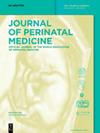Amniotic fluid embolism: a reappraisal
IF 1.7
4区 医学
Q3 OBSTETRICS & GYNECOLOGY
引用次数: 0
Abstract
Objectives Using cases from our own experience and from the published literature on amniotic fluid embolism (AFE), we seek to improve on existing criteria for diagnosis and discern associated risk factors. Additionally, we propose a novel theory of pathophysiology. Methods This retrospective case review includes eight cases of AFE from two hospital systems and 21 from the published literature. All cases were evaluated using the modified criteria for research reporting of AFE by Clark et al. in Am J Obstet Gynecol, 2016;215:408–12 as well as our proposed criteria for diagnosis. Additional clinical and demographic characteristics potentially correlated with a risk of AFE were included and analyzed using descriptive analysis. Results The incidence of AFE was 2.9 per 100,000 births, with five maternal deaths in 29 cases (17.2 %) in our series. None of the cases met Clark’s criteria while all met our criteria. 62.1 % of patients were over the age of 32 years and two out of 29 women (6.9 %) conceived through羊水栓塞:再评价
目的 利用我们自身的经验和已发表的羊水栓塞(AFE)文献中的病例,我们试图改进现有的诊断标准,并找出相关的风险因素。此外,我们还提出了一种新的病理生理学理论。方法 本次回顾性病例审查包括来自两家医院系统的 8 例 AFE 病例和来自已发表文献的 21 例 AFE 病例。所有病例均采用克拉克等人在《美国妇产科杂志》(Am J Obstet Gynecol)2016;215:408-12 中修改的 AFE 研究报告标准以及我们提出的诊断标准进行评估。此外,还纳入了可能与 AFE 风险相关的其他临床和人口学特征,并采用描述性分析方法进行了分析。结果 AFE 的发生率为每 10 万名新生儿中 2.9 例,在我们的系列研究中,29 例(17.2%)中有 5 名产妇死亡。没有一个病例符合克拉克标准,而所有病例都符合我们的标准。62.1%的患者年龄在 32 岁以上,29 名产妇中有 2 名(6.9%)是通过体外受精受孕的。6.5%的病例并发胎儿死亡。前置胎盘发生率为 13.8%。86.2%的产妇接受了剖宫产手术,其中52.0%的产妇没有急性产科指征。结论 与其他标准相比,我们的标准能识别出更多的 AFE 患者,而出现假阳性的可能性较低。我们审查的临床和人口统计学关联与之前报道的一致。根据我们的标准,剖宫产与 AFE 风险之间可能存在关系。此外,我们还提出了一个新的病理生理学假设。
本文章由计算机程序翻译,如有差异,请以英文原文为准。
求助全文
约1分钟内获得全文
求助全文
来源期刊

Journal of Perinatal Medicine
医学-妇产科学
CiteScore
4.40
自引率
8.30%
发文量
183
审稿时长
4-8 weeks
期刊介绍:
The Journal of Perinatal Medicine (JPM) is a truly international forum covering the entire field of perinatal medicine. It is an essential news source for all those obstetricians, neonatologists, perinatologists and allied health professionals who wish to keep abreast of progress in perinatal and related research. Ahead-of-print publishing ensures fastest possible knowledge transfer. The Journal provides statements on themes of topical interest as well as information and different views on controversial topics. It also informs about the academic, organisational and political aims and objectives of the World Association of Perinatal Medicine.
 求助内容:
求助内容: 应助结果提醒方式:
应助结果提醒方式:


